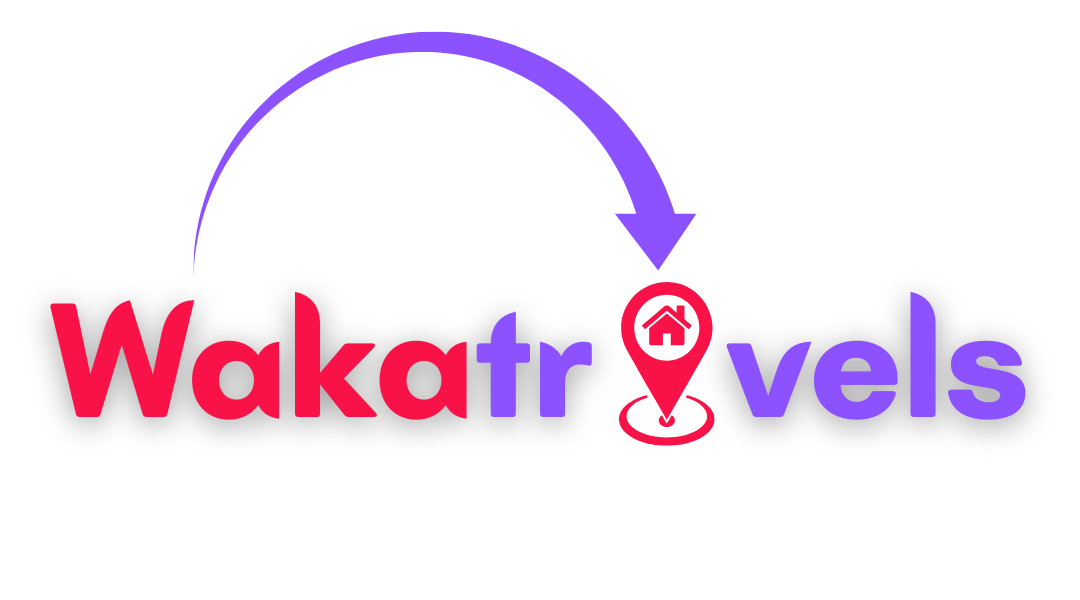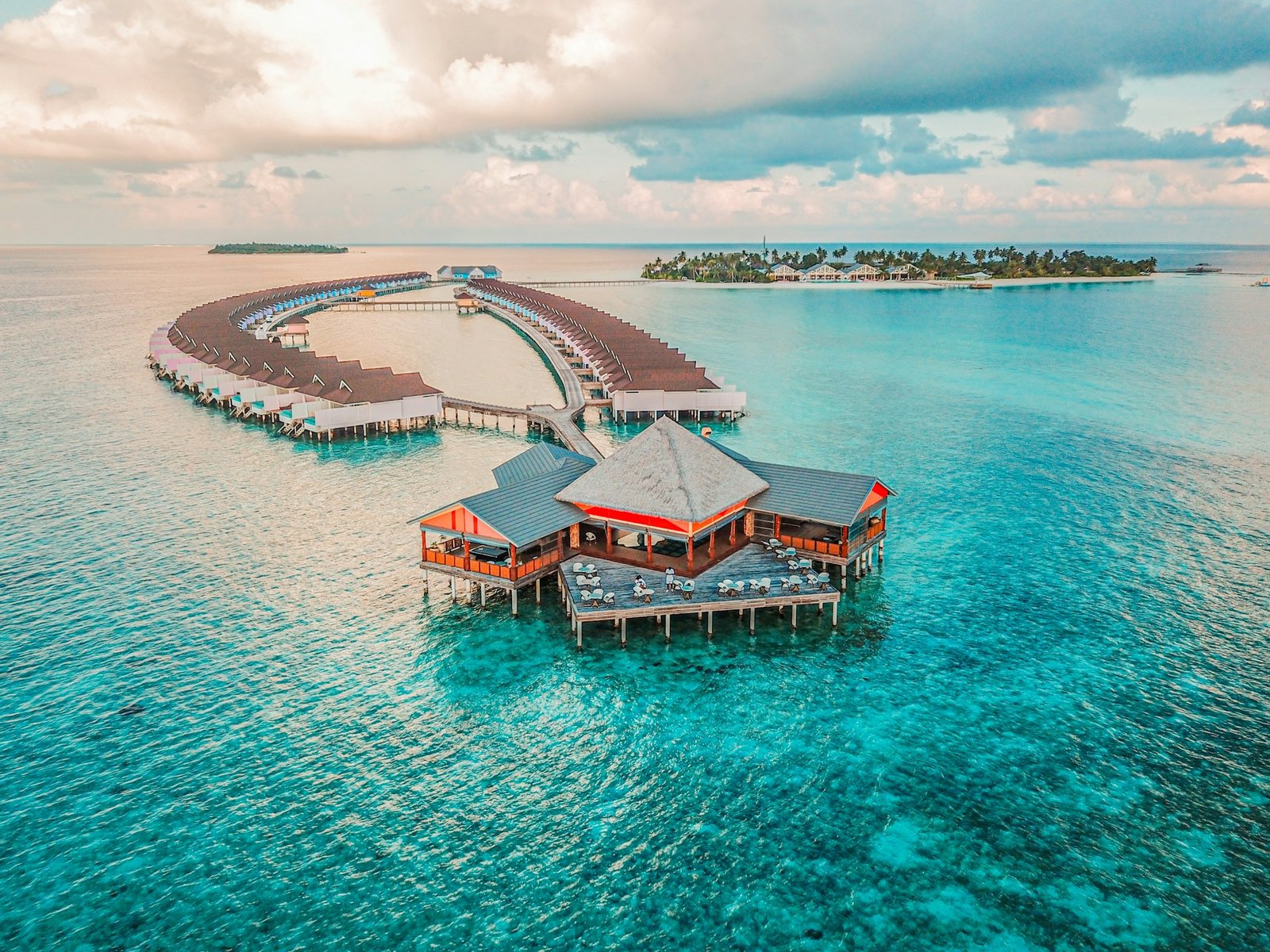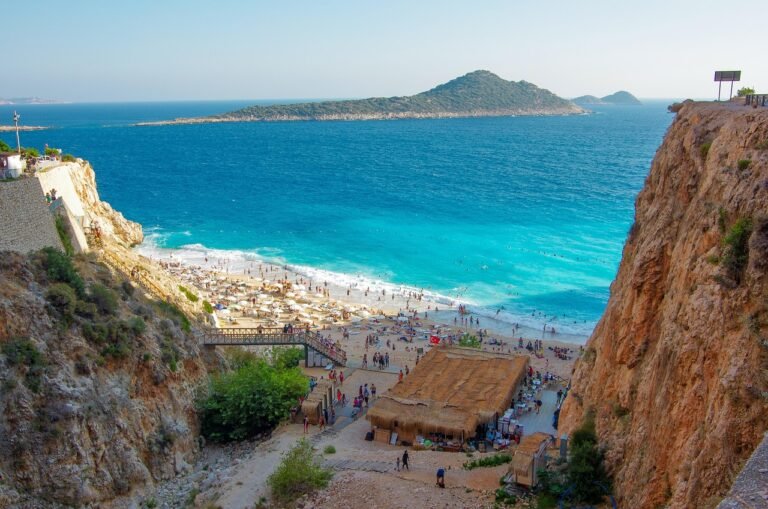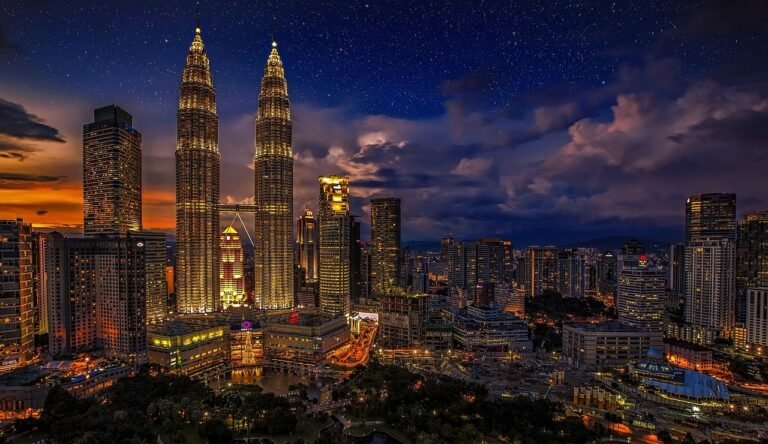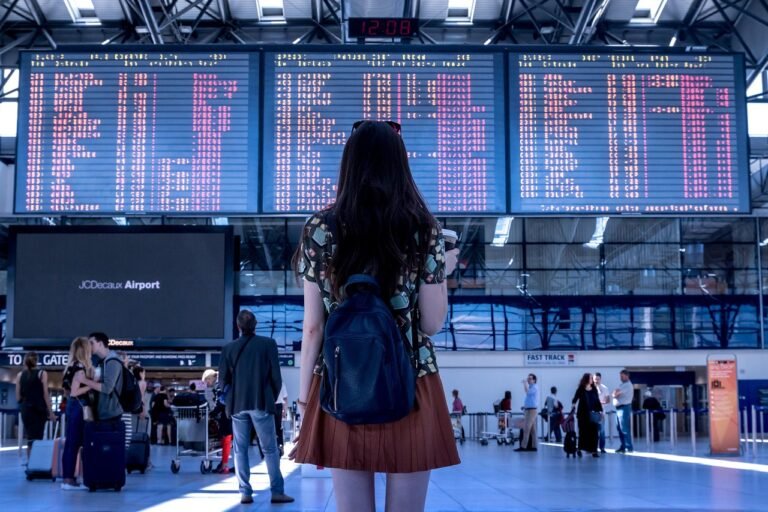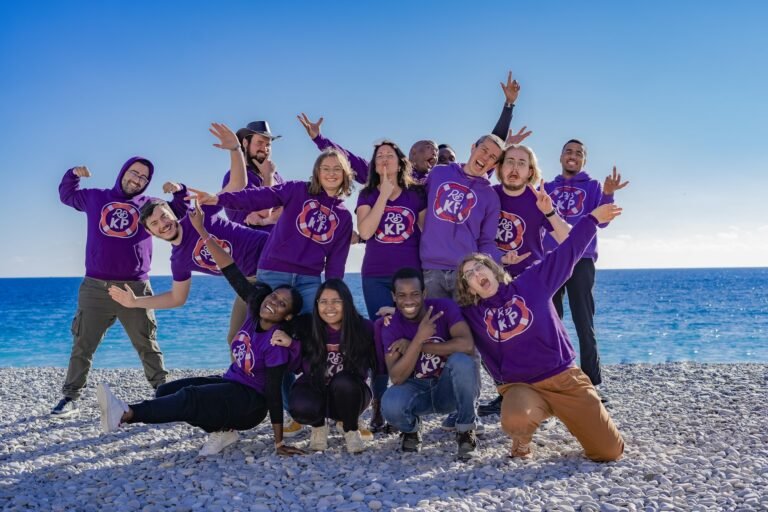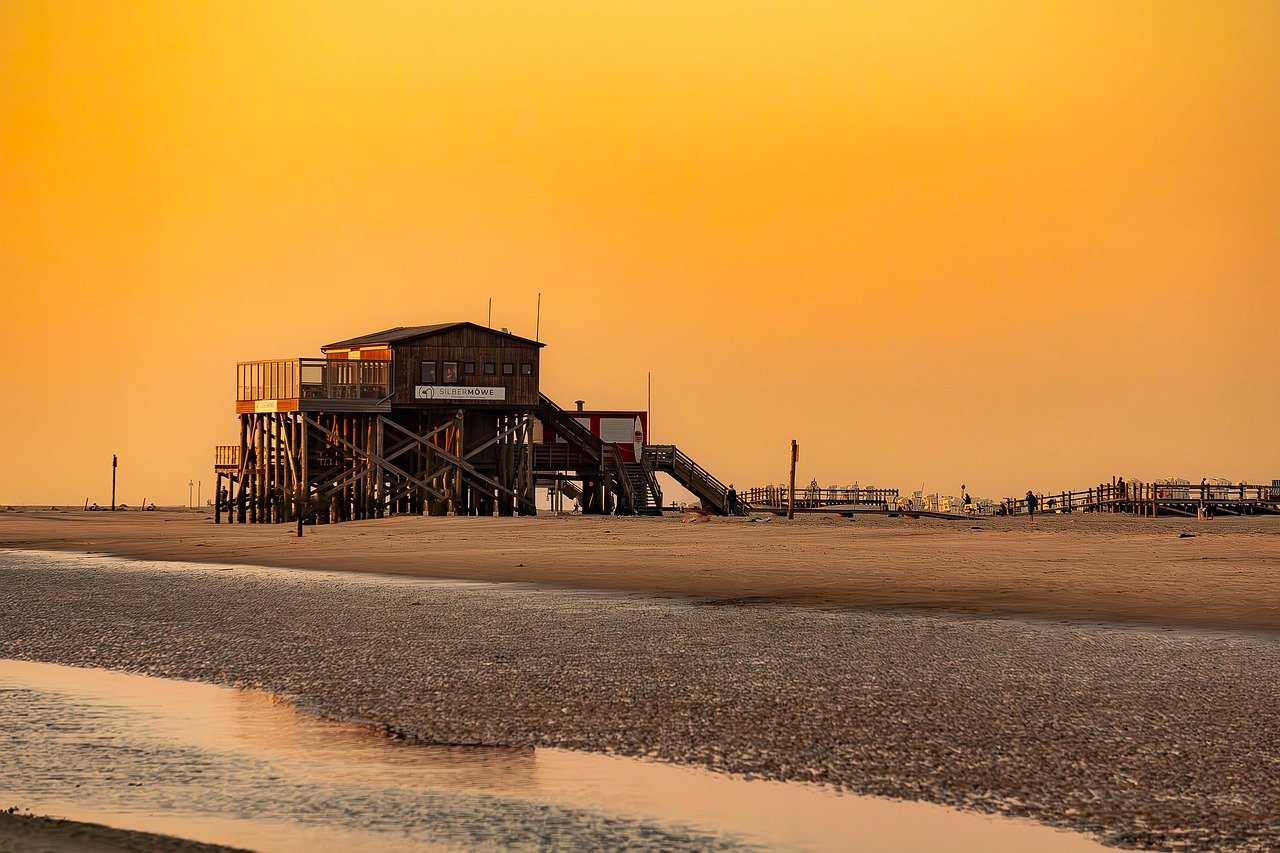
Paradise on $50 a day? Sounds like a dream painted by someone who’s never actually seen a vacation tab. But hear me out—there are corners of the world where that number, modest as it seems, stretches far beyond what you’d expect. Think less mainstream chaos and more hidden gems, where budget doesn’t mean scrimping on experience but rather knowing where to look, when to visit, and how to live like a local without mortgaging next year’s rent.
Now, this isn’t the usual “backpack through Europe and eat street kebabs” spiel. Nope. We’re talking destinations that offer a genuine oasis for your wallet and—if you’re lucky—a splash of that elusive ‘paradise’ vibe. Places where the sun sets with a cocktail that won’t break your bank, where the markets buzz with color and flavor, and where your $50 can actually sway between lodging, meals, and a smattering of local adventures.
Of course, it’s not a perfect formula; some days, the budget might feel tight, the charm skewed, or that paradise somewhat elusive. But that’s part of the thrill, right? The search for affordable wonder, the dance between inexpensive and incredible. So buckle up, or loosen your belt—whatever—you’re about to uncover some not-so-obvious spots where fifty bucks a day isn’t a prison, but a passport to something surprisingly lush.
The Real Cost of Paradise: What $50 Actually Gets You
Let’s be honest about this $50 figure. I’m not talking about surviving on instant noodles and sleeping in train stations. This is comfortable budget travel—clean accommodation, decent meals, local transport, and enough left over for that sunset beer or temple entrance fee that makes the whole trip worthwhile.
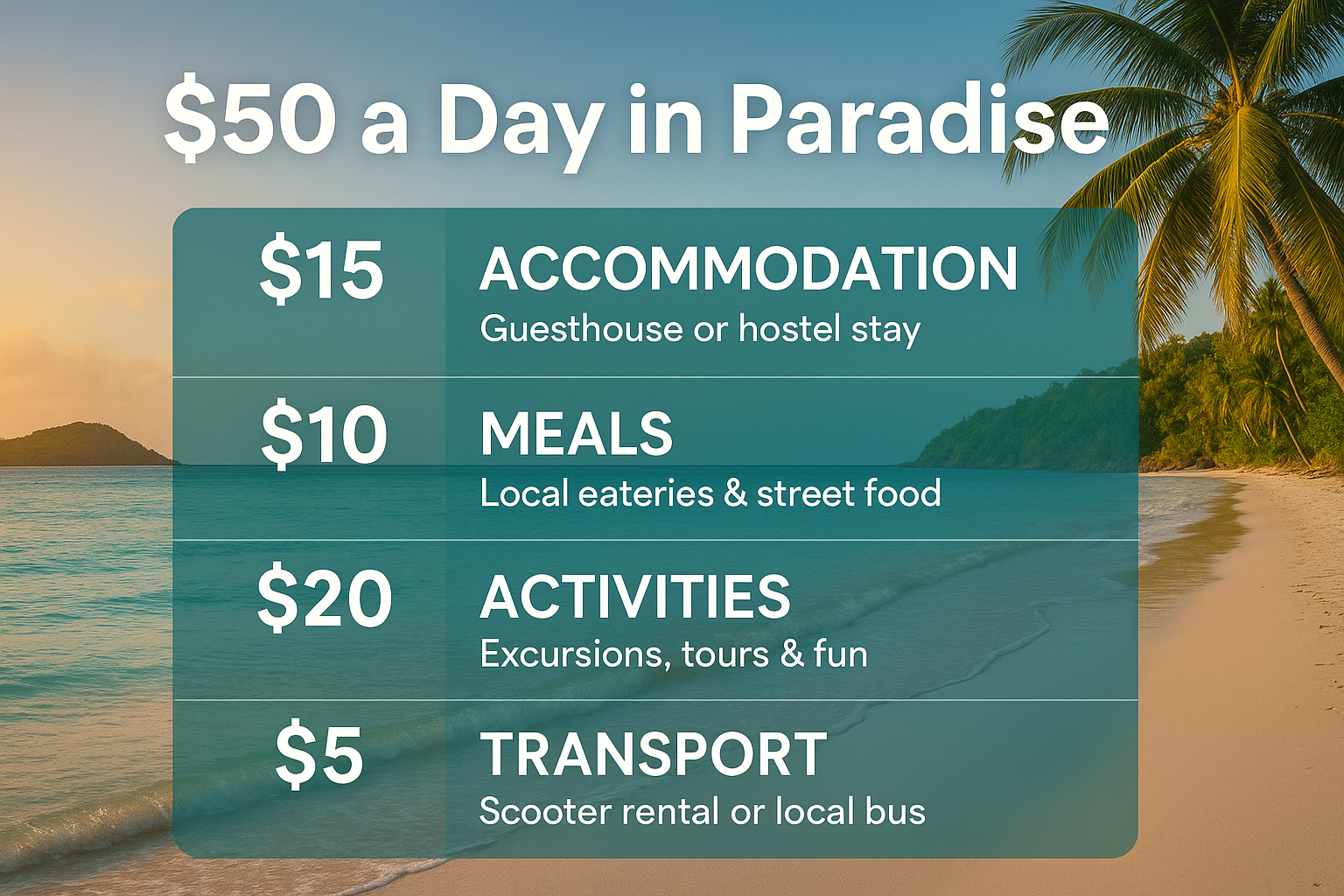
The magic happens when you shift your mindset from “cheap” to “clever.” Instead of hunting for the lowest prices everywhere, you’re looking for destinations where your money simply stretches further. Where $15 doesn’t buy you a sad sandwich, but a feast for three people.
Vietnam: Where $50 Feels Like $200
Daily Budget Breakdown:
- Accommodation: $12-18 (decent guesthouse or hostel private room)
- Food: $8-12 (street food breakfast, local restaurant lunch, nice dinner)
- Transport: $3-8 (motorbike taxi, local bus, occasional Grab)
- Activities: $5-15 (temple visits, cooking classes, boat trips)
Vietnam knocked me sideways. Not just because of that infamous motorbike chaos in Ho Chi Minh City (though nearly getting flattened by a scooter carrying a family of four plus groceries was… memorable), but because of how far money goes here.
I spent two weeks eating like royalty. Pho for breakfast that cost $2 and tasted better than anything I’d paid £15 for in Soho. Fresh spring rolls made while I watched. Coffee so strong it could wake the dead, served with condensed milk in tiny plastic chairs that somehow became the most comfortable spot in the world.
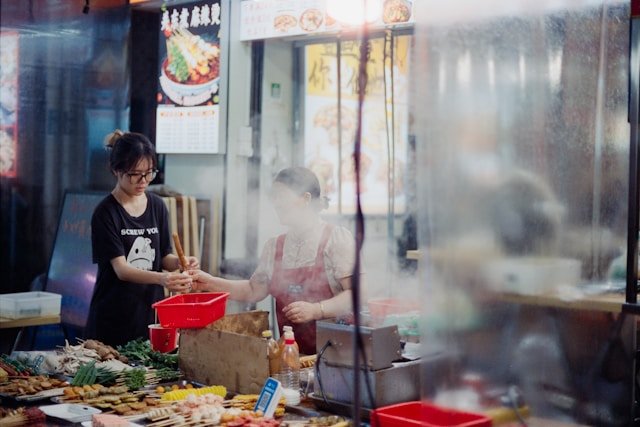
The beaches around Hoi An rival anything in Thailand, minus the crowds and inflated prices. Accommodation? I stayed in a family-run guesthouse where the owner’s mother brought me homemade rice paper rolls every morning and practiced her English by asking about my love life. Try getting that personal touch at a Marriott.
But Vietnam’s real gift isn’t just affordability—it’s authenticity. You’re not in a tourist bubble. You’re sharing meals with locals, navigating real neighborhoods, figuring out how to order coffee without a word of Vietnamese (lots of pointing, surprisingly effective).
Guatemala: Central America’s Best-Kept Secret
Daily Budget Breakdown:
- Accommodation: $8-15 (hostel dorm to budget hotel)
- Food: $6-10 (local comedores, street food, occasional restaurant meal)
- Transport: $5-12 (chicken buses, tuk-tuks, local shuttles)
- Activities: $8-20 (volcano hikes, Mayan ruins, lake activities)
Guatemala showed up uninvited to my travel bucket list and never left. I originally planned it as a quick stopover between Mexico and Costa Rica. Three months later, I was still there.
Lake Atitlán might be the most beautiful place I’ve never seen on anyone’s Instagram stories. Surrounded by volcanoes, dotted with Mayan villages where women still wear traditional dress not for tourists but because it’s Tuesday. You can stay in San Pedro La Laguna for weeks, learning Spanish from local teachers who charge $6 an hour, eating in family restaurants where dinner costs less than a London coffee.
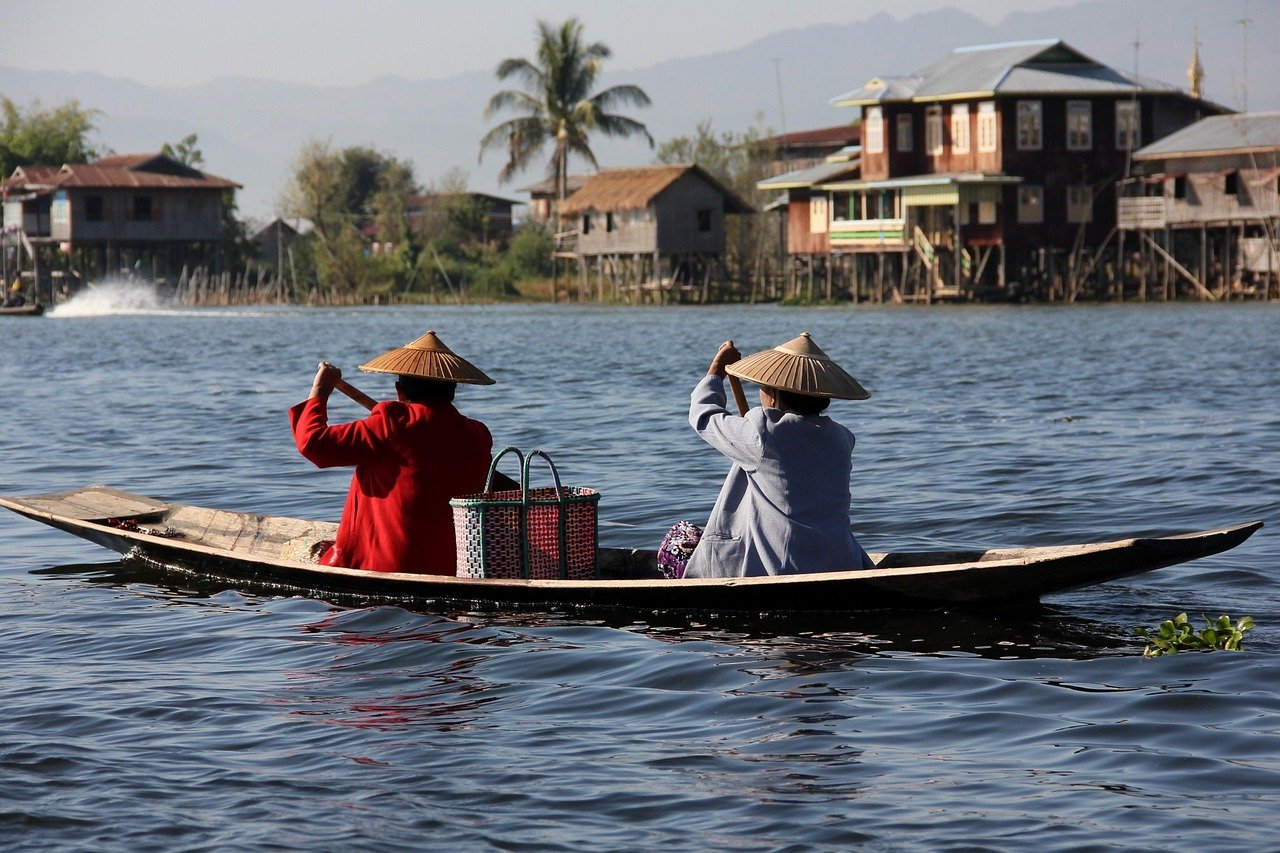
The chicken buses deserve their own travel memoir. Converted American school buses painted in colors that would make a peacock jealous, packed with farmers heading to market, students, and the occasional bewildered backpacker (me). Uncomfortable? Absolutely. Authentic cultural experience you can’t buy? Priceless.
Tikal ruined other archaeological sites for me. Climbing ancient Mayan pyramids while howler monkeys provided the soundtrack felt like discovering something secret, even though it’s a UNESCO World Heritage site. The difference is timing and tourism infrastructure—or lack thereof. You’re not fighting selfie sticks for pyramid views.
Indonesia Beyond Bali: Java and Yogyakarta
Daily Budget Breakdown:
- Accommodation: $10-20 (guesthouse or budget hotel)
- Food: $5-12 (warungs, local restaurants, street food)
- Transport: $3-10 (local buses, ojek, train)
- Activities: $8-18 (temple entries, cultural performances, workshops)
Everyone goes to Bali. I get it—those rice terraces are Instagram gold. But Java, Indonesia’s cultural heartland, offers everything Bali does minus the Australian bachelor parties and inflated prices.
Yogyakarta (locals call it Jogja, and you should too if you want to blend in) became my favorite Indonesian surprise. The sultan still lives in the city center palace. Traditional batik artists work in family workshops that have operated for generations. Street food culture rivals Vietnam’s, with gudeg (young jackfruit curry) becoming my unexpected obsession.
Borobudur and Prambanan temples rival Angkor Wat for architectural magnificence but cost a fraction to visit and explore. I climbed Borobudur for sunrise (yes, cliché, but some clichés exist for good reasons) and had the experience nearly to myself. Try doing that at Angkor Wat without booking six months ahead and paying premium prices.
The real magic happened in Solo (Surakarta), Java’s other royal city. I stumbled into a traditional Javanese wedding celebration—complete strangers invited me to join, explaining ceremonies between courses of incredible food. That kind of spontaneous cultural immersion doesn’t happen in heavily touristed destinations.
Nepal: Himalayan Adventures Without the Hefty Price Tag
Daily Budget Breakdown:
- Accommodation: $8-18 (guesthouse, teahouse on treks)
- Food: $4-10 (dal bhat, local restaurants, trekking meals)
- Transport: $2-8 (local buses, shared jeeps)
- Activities: $15-25 (trekking permits, cultural sites, guides)
Nepal taught me that some of the world’s most spectacular adventures cost remarkably little. The Annapurna Circuit, one of the planet’s legendary treks, costs about what you’d spend on a weekend city break in Europe.
I’ll be honest—trekking in Nepal isn’t luxury travel. You’re sleeping in basic teahouses, washing with cold water (if you’re lucky), and your bathroom might be a hole in the ground with Himalayan views. But watching sunrise over 8,000-meter peaks while eating dal bhat prepared by a Gurung family in their mountain home? That’s worth every uncomfortable moment.
Kathmandu gets unfairly dismissed as chaotic and polluted (okay, it is both those things), but it’s also intensely alive in ways sanitized tourist destinations never manage. Hindu and Buddhist temples coexist on the same streets. Tibetan refugees sell jewelry next to traditional Newari craftsmen. Travelers gather in Thamel guesthouses sharing stories and planning adventures.
The real revelation was Pokhara, Nepal’s lake city. Phewa Lake reflects the Annapurna range on clear mornings, creating those mirror-perfect mountain photos without the Swiss price tag. I spent weeks there, planning treks, taking yoga classes, and eating the best momos (Tibetan dumplings) of my life for about $2 per serving.
Bolivia: South America’s Affordable Andean Adventure
Daily Budget Breakdown:
- Accommodation: $10-18 (hostel or basic hotel)
- Food: $5-12 (local restaurants, markets, street food)
- Transport: $8-15 (buses, collectivos, occasional flight)
- Activities: $20-40 (Salar de Uyuni tours, national parks, city tours)
Bolivia deserves more love than it gets. Landlocked between Peru and Chile, it often gets skipped by South American backpacker circuits. Their loss, your gain.
La Paz, the world’s highest capital city, initially left me breathless (literally—altitude is real). But give it time. The city grows on you like altitude acclimatization. Indigenous culture isn’t performed for tourists; it’s lived daily. Markets overflow with ingredients I couldn’t identify. Cable cars provide public transport with views that would cost hundreds elsewhere.

Salar de Uyuni, the world’s largest salt flat, creates the most otherworldly landscape I’ve experienced. During dry season, it’s blindingly white crystalline desert. Rainy season transforms it into a perfect mirror reflecting sky and clouds. Tour operators charge a fraction of what similar unique experiences cost elsewhere.
The three-day tour to Salar de Uyuni—including accommodation, meals, transportation, and guide—cost less than a single night in an average European hotel. We saw flamingo-filled colored lakes, hot springs at 4,000 meters altitude, and stayed in a hotel made entirely of salt blocks.
The Art of Living Like a Local (Without Actually Being One)
Budget travel isn’t about deprivation—it’s about priorities and local integration. Here’s what I learned about stretching money without sacrificing experiences:
Eat where locals eat. That tiny restaurant with no English menu and plastic chairs? Probably serves the best food you’ll have. Plus, meals cost what locals can afford, not what tourists will pay.
Use local transport. Yes, chicken buses are chaotic. Local trains are slow. But they’re also cultural experiences and cost pennies compared to tourist shuttles or taxis.
Stay in neighborhoods, not tourist zones. Guesthouses in residential areas cost half what beachfront hotels charge, and you’ll experience actual daily life instead of a tourist simulation.
Learn basic phrases. “Hello,” “thank you,” “how much?” and “where is the bathroom?” in local languages opens doors and hearts. Plus, vendors often give better prices to tourists who make the effort.
Be flexible with timing. Visit during shoulder seasons. Fly mid-week. Take overnight buses instead of domestic flights. Flexibility saves serious money.
When Budget Travel Goes Wrong (And Why That’s Okay)
Let me tell you about my worst budget travel day. Picture this: 14-hour bus ride through the Bolivian Andes, temperature dropping below freezing, heating broken, and my genius decision to pack summer clothes because “it’s South America, how cold can it get?”
I spent the night wrapped in every piece of clothing I owned, sharing body warmth with a Quechua grandmother who found my suffering hilarious. She shared her coca tea and taught me Andean curse words I probably shouldn’t repeat.
Was it comfortable? Absolutely not. Would I change it? Never.
Those uncomfortable moments become the stories you tell for decades. They’re also when local kindness shines brightest. People help struggling travelers in ways that restore faith in humanity.
Budget travel strips away comfort zones and forces authentic interactions. You can’t insulate yourself in luxury hotels and private transfers. You have to engage with places and people as they actually are, not as tourism boards present them.
Making $50 Work: Practical Tips That Actually Matter
Accommodation Strategies:
- Book guesthouses directly, not through booking sites
- Look for family-run places in residential neighborhoods
- Consider homestays for cultural immersion and lower costs
- Use hostel private rooms instead of budget hotels
- Stay longer for better weekly/monthly rates
Food Budget Hacks:
- Eat breakfast where you’re staying (often included)
- Make lunch your big meal (lunch specials cost less than dinner)
- Shop at local markets for snacks and fruit
- Try street food, but use common sense about cleanliness
- Ask locals for restaurant recommendations
Transport Savings:
- Use local transport apps (like Grab in Southeast Asia)
- Book long-distance transport directly at stations
- Travel during off-peak hours
- Consider overnight buses to save accommodation costs
- Walk when possible—cities reveal themselves on foot
Activity Budget Management:
- Focus on free or low-cost cultural experiences
- Visit museums on free or discounted days
- Take walking tours with local guides
- Explore nature—beaches, mountains, and parks cost nothing
- Learn skills like cooking or crafts from locals
The Real Value of Budget Paradise
After years of budget travel, I’ve realized something counterintuitive: the less you spend on travel, the more you often get from it.
When you’re not staying in resort bubbles, you meet people you’d never encounter otherwise. When you eat where locals eat, you taste authentic flavors, not tourist approximations. When you travel like locals travel, you see how places actually function.
These destinations I’ve shared aren’t just cheap—they’re transformative. They challenge assumptions, expand perspectives, and create memories that cost-per-experience ratio makes luxury travel look like poor value.
Vietnam taught me that language barriers dissolve over shared meals. Guatemala showed me that natural beauty doesn’t require developed tourism infrastructure. Indonesia proved that cultural depth exists beyond famous destinations. Nepal demonstrated that adventure doesn’t require expensive equipment or guided expeditions. Bolivia reminded me that the most unique experiences often happen in places tourists overlook.
The $50 daily budget isn’t a limitation—it’s liberation from the expensive-equals-better travel mentality. It opens destinations that would otherwise remain fantasies, extends trip durations, and creates space for spontaneity.
More importantly, budget travel makes regular travel possible. Instead of saving for years for one expensive vacation, you can travel frequently, exploring multiple destinations for the cost of single luxury trip.
Your Next Adventure Awaits (And Your Bank Account Will Thank You)
The destinations nobody talks about are waiting. Vietnam’s motorbike chaos and incredible pho. Guatemala’s volcanic lakes and Mayan villages. Java’s ancient temples and royal cities. Nepal’s Himalayan sunrises and mountain hospitality. Bolivia’s salt flats and high-altitude adventures.
They’re not on every travel blog because they require slightly more effort, cultural sensitivity, and adventure spirit than resort destinations. But that’s exactly what makes them special.
Your $50-per-day paradise isn’t a compromise—it’s an upgrade to authentic travel experiences that money often can’t buy in overdeveloped destinations.
So close those expensive resort tabs. Start researching Vietnamese guesthouses, Guatemalan chicken bus routes, and Indonesian ferry schedules. Your next great adventure is probably more affordable than you imagined.
The only question is: which underrated paradise will you discover first?
Frequently Asked Questions
What countries can you travel to for $50 per day?
Many Southeast Asian countries (Vietnam, Cambodia, Laos), Central American destinations (Guatemala, Nicaragua), South Asian countries (Nepal, India), Eastern European nations (Ukraine, Bulgaria), and some South American countries (Bolivia, Ecuador) offer excellent value for budget travelers.
How do you find cheap accommodation while traveling?
H5: Book directly with guesthouses, use local booking sites, stay in residential neighborhoods away from tourist zones, consider homestays, and look for family-run establishments that often offer better rates and more personal service.
Is it safe to eat street food on a budget?
Street food can be both safe and delicious when you choose vendors with high turnover, watch food being prepared fresh, avoid raw ingredients in questionable areas, and follow where locals eat. Trust your instincts and start slowly to adjust your system.
What’s the best way to get around on a budget?
H5: Use local public transportation, walk when possible, book transport directly at stations rather than through tourism agencies, consider overnight buses to save on accommodation, and download local ride-sharing apps for affordable short-distance travel.
How much should I budget for activities and sightseeing?
Allocate 20-30% of your daily budget for activities. Focus on free cultural experiences, natural attractions, walking tours, and local festivals. Many of the best travel experiences—beaches, hiking trails, markets, and cultural immersion—cost very little or nothing.
Do I need travel insurance for budget destinations?
Travel insurance is essential, especially for budget destinations where medical facilities might be basic. Choose coverage that includes medical evacuation, as this could save you tens of thousands if serious illness or injury occurs.
How do I handle money and ATMs in budget travel destinations?
Research ATM availability and fees before traveling, notify your bank of travel plans, carry backup cards, keep cash in multiple locations, and learn local tipping customs. Some destinations still operate primarily on cash.
What should I pack for budget travel?
Pack light, versatile clothing suitable for the climate, basic medical supplies, universal adapter, portable charger, quick-dry towel, and copies of important documents. Avoid overpacking—you can buy most necessities locally for less.
How do I communicate without speaking the local language?
Learn basic phrases (hello, thank you, excuse me), download translation apps that work offline, carry a phrase book, use gestures and pointing, and be patient and friendly. Most people appreciate effort to communicate.
When is the best time to visit budget destinations?
Travel during shoulder seasons for better weather and fewer crowds, avoid holidays and festivals when prices spike, consider rainy seasons for significant savings if you can handle some weather challenges, and be flexible with dates for better deals.
How do I plan a multi-country budget trip?
Research visa requirements early, plan routes that minimize backtracking, use overland transport when possible, allow flexibility in your itinerary, and consider regional budget airline passes for longer distances.
What are the biggest mistakes budget travelers make?
Over-planning rigid itineraries, staying only in tourist areas, not learning basic local phrases, carrying too much cash in one place, ignoring local customs, and focusing solely on saving money rather than having meaningful experiences.
Top Budget Travel Recommendations
1. Vietnam Backpacker Hostels – vietnambackpackerhostels.com Clean, social accommodation with local tour connections throughout Vietnam.
2. Guatemala Shuttle Services – guatemalashuttle.com Reliable transport between major destinations at reasonable rates.
3. Nepal Trekking Permits – welcomenepal.com Official trekking permit information and requirements for major hiking routes.
4. Indonesia Ferry Schedules – pelni.co.id National ferry company connecting Indonesia’s islands affordably.
5. Bolivia Salt Flat Tours – redcapnomada.com Reputable tour operator for Salar de Uyuni multi-day expeditions.
6. Southeast Asia Budget Airlines – airasia.com Regional low-cost carrier connecting major budget destinations.
7. Hostelworld – hostelworld.com International hostel booking platform with detailed reviews and photos.
8. Rome2Rio – rome2rio.com Transport route planning tool showing all options between destinations.
9. XE Currency – xe.com Real-time currency conversion and rate tracking for budget planning.
10. Grab App – grab.com Southeast Asian ride-sharing and delivery app for affordable transport.
11. Google Translate – translate.google.com Essential offline translation tool for navigating language barriers.
12. Maps.me – maps.me Offline mapping application crucial for budget travelers without constant internet.
13. Travel Insurance Comparison – worldnomads.com Comprehensive travel insurance specifically designed for backpackers and budget travelers.
14. Budget Accommodation – booking.com Global accommodation booking with filters for budget-friendly options.
15. Local Food Discovery – eatwith.com Platform connecting travelers with local dining experiences and cooking classes.
16. Currency Exchange – transferwise.com International money transfer service with competitive exchange rates.
17. Vaccination Information – cdc.gov/travel Official health and vaccination requirements for international destinations.
18. Budget Flight Search – skyscanner.com Comprehensive flight comparison tool with flexible date options.
19. Visa Requirements – visadb.io Up-to-date visa requirements and application information by destination.
20. Local SIM Cards – prepaidgsm.net Information about local SIM cards and mobile data options worldwide.
